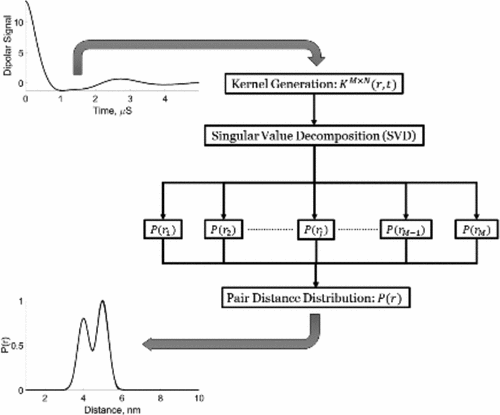当前位置:
X-MOL 学术
›
J. Phys. Chem. Lett.
›
论文详情
Our official English website, www.x-mol.net, welcomes your
feedback! (Note: you will need to create a separate account there.)
Singular Value Decomposition Method to Determine Distance Distributions in Pulsed Dipolar Electron Spin Resonance
The Journal of Physical Chemistry Letters ( IF 4.8 ) Pub Date : 2017-11-07 00:00:00 , DOI: 10.1021/acs.jpclett.7b02379 Madhur Srivastava 1 , Jack H. Freed 1
The Journal of Physical Chemistry Letters ( IF 4.8 ) Pub Date : 2017-11-07 00:00:00 , DOI: 10.1021/acs.jpclett.7b02379 Madhur Srivastava 1 , Jack H. Freed 1
Affiliation

|
Regularization is often utilized to elicit the desired physical results from experimental data. The recent development of a denoising procedure yielding about 2 orders of magnitude in improvement in SNR obviates the need for regularization, which achieves a compromise between canceling effects of noise and obtaining an estimate of the desired physical results. We show how singular value decomposition (SVD) can be employed directly on the denoised data, using pulse dipolar electron spin resonance experiments as an example. Such experiments are useful in measuring distances and their distributions, P(r) between spin labels on proteins. In noise-free model cases exact results are obtained, but even a small amount of noise (e.g., SNR = 850 after denoising) corrupts the solution. We develop criteria that precisely determine an optimum approximate solution, which can readily be automated. This method is applicable to any signal that is currently processed with regularization of its SVD analysis.
中文翻译:

确定脉冲双极电子自旋共振距离分布的奇异值分解方法
正则化通常用于从实验数据中得出所需的物理结果。去噪过程的最新发展在信噪比(SNR)方面提高了大约2个数量级,从而消除了对正则化的需求,该正则化实现了噪声消除效果与获得所需物理结果的估计之间的折衷。我们以脉冲偶极电子自旋共振实验为例,说明如何将奇异值分解(SVD)直接用于降噪后的数据。这样的实验对于测量距离及其分布P(r)在蛋白质上的自旋标记之间。在无噪声模型的情况下,可以获得准确的结果,但是即使是少量的噪声(例如,去噪后的SNR = 850)也会破坏解决方案。我们开发可精确确定最佳近似解决方案的标准,该解决方案可以很容易地实现自动化。此方法适用于当前对其SVD分析进行正则化处理的任何信号。
更新日期:2017-11-08
中文翻译:

确定脉冲双极电子自旋共振距离分布的奇异值分解方法
正则化通常用于从实验数据中得出所需的物理结果。去噪过程的最新发展在信噪比(SNR)方面提高了大约2个数量级,从而消除了对正则化的需求,该正则化实现了噪声消除效果与获得所需物理结果的估计之间的折衷。我们以脉冲偶极电子自旋共振实验为例,说明如何将奇异值分解(SVD)直接用于降噪后的数据。这样的实验对于测量距离及其分布P(r)在蛋白质上的自旋标记之间。在无噪声模型的情况下,可以获得准确的结果,但是即使是少量的噪声(例如,去噪后的SNR = 850)也会破坏解决方案。我们开发可精确确定最佳近似解决方案的标准,该解决方案可以很容易地实现自动化。此方法适用于当前对其SVD分析进行正则化处理的任何信号。











































 京公网安备 11010802027423号
京公网安备 11010802027423号